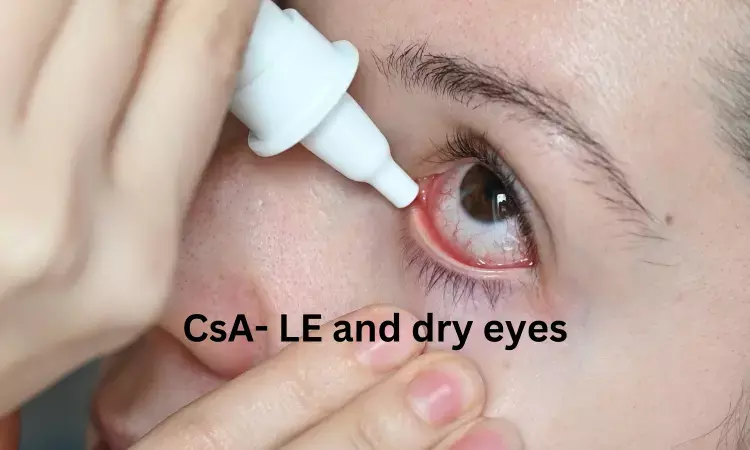- Home
- Medical news & Guidelines
- Anesthesiology
- Cardiology and CTVS
- Critical Care
- Dentistry
- Dermatology
- Diabetes and Endocrinology
- ENT
- Gastroenterology
- Medicine
- Nephrology
- Neurology
- Obstretics-Gynaecology
- Oncology
- Ophthalmology
- Orthopaedics
- Pediatrics-Neonatology
- Psychiatry
- Pulmonology
- Radiology
- Surgery
- Urology
- Laboratory Medicine
- Diet
- Nursing
- Paramedical
- Physiotherapy
- Health news
- Fact Check
- Bone Health Fact Check
- Brain Health Fact Check
- Cancer Related Fact Check
- Child Care Fact Check
- Dental and oral health fact check
- Diabetes and metabolic health fact check
- Diet and Nutrition Fact Check
- Eye and ENT Care Fact Check
- Fitness fact check
- Gut health fact check
- Heart health fact check
- Kidney health fact check
- Medical education fact check
- Men's health fact check
- Respiratory fact check
- Skin and hair care fact check
- Vaccine and Immunization fact check
- Women's health fact check
- AYUSH
- State News
- Andaman and Nicobar Islands
- Andhra Pradesh
- Arunachal Pradesh
- Assam
- Bihar
- Chandigarh
- Chattisgarh
- Dadra and Nagar Haveli
- Daman and Diu
- Delhi
- Goa
- Gujarat
- Haryana
- Himachal Pradesh
- Jammu & Kashmir
- Jharkhand
- Karnataka
- Kerala
- Ladakh
- Lakshadweep
- Madhya Pradesh
- Maharashtra
- Manipur
- Meghalaya
- Mizoram
- Nagaland
- Odisha
- Puducherry
- Punjab
- Rajasthan
- Sikkim
- Tamil Nadu
- Telangana
- Tripura
- Uttar Pradesh
- Uttrakhand
- West Bengal
- Medical Education
- Industry
Cyclosporine and loteprednol combo bests cyclosporine alone in improving dry eye disease

Dry eye has gained its importance as public health problem given its high prevalence, morbidity and cost implications with increased use of gadgets. Although dry eye is common and affects patients’ quality of life, only one medication, cyclosporine 0.05% emulsion, has been approved by the US FDA for its treatment.
A recent study in Clinical Opthalmology aimed to examine the efficacy and tolerability of a combination of cyclosporine 0.1% and loteprednol 0.2% (CsA–LE; Klarity CL) in comparison to commercially available cyclosporine 0.05% (CsA; Restasis) in improving signs and symptoms of dry eye.
The study suggests that on comparison with both the drugs for treatment of dry eyes i.e one with cyclosporine 0.05% alone and one with a combination of cyclosporine 0.1% and loteprednol 0.2%. Both regimens improved ocular surface health, but the combination regimen also improved irregularities of the cornea more effectively than cyclosporine alone.
The researchers conducted a multicenter, prospective, randomized, controlled, open-label study evaluated 60 patients randomized to a single treatment for 4 weeks and evaluated at day 0, day 14, and day 28. Comparison was made of corneal higher-order aberrations (HOAs), dry-eye symptoms (SPEED score), tear-breakup time (TBUT), corneal staining, and ocular hyperemia, as well as tolerability of each medication with the validated COMTOL instrument.
The key findings of the study are
• A total of 56 patients completed enrollment. Corneal HOAs improved significantly with CsA–LE, but not CsA alone.
• Both groups showed significant improvement (with no significant differences between groups) in SPEED scores, corneal staining, TBUT, and conjunctival hyperemia.
• Tolerability was similar between the drugs, and no significant safety issues were identified.
Researchers concluded that “The combination of CsA 0.1%–LE 0.2% provided significant improvement in corneal HOAs, while CsA 0.05% did not. For all other measures of ocular surface improvement, both medications showed similar benefits. Tolerability was comparable between the formulations. When rapid rehabilitation of the ocular surface is needed to reduce aberrations, CsA–LE is an appropriate choice.”
Reference: Hovanesian J, Chester T, Sorenson RC. A Prospective Study of Cyclosporine A 0.1% Combined with Loteprednol 0.2% vs Cyclosporine A 0.05% Alone in the Treatment of Dry Eye. Clin Ophthalmol. 2023;17:2181-2191, DOI:https://doi.org/10.2147/OPTH.S419600.
MSc. Neuroscience
Niveditha Subramani a MSc. Neuroscience (Faculty of Medicine) graduate from University of Madras, Chennai. Ambitious in Neuro research having worked in motor diseases and neuron apoptosis is interested in more of new upcoming research and their advancement in field of medicine. She has an engrossed skill towards writing and her roles at Medical dialogue include Sr. Content writer. Her news covers new discoveries and updates in field of medicine. She can be reached at editorial@medicaldialogues.in
Dr Kamal Kant Kohli-MBBS, DTCD- a chest specialist with more than 30 years of practice and a flair for writing clinical articles, Dr Kamal Kant Kohli joined Medical Dialogues as a Chief Editor of Medical News. Besides writing articles, as an editor, he proofreads and verifies all the medical content published on Medical Dialogues including those coming from journals, studies,medical conferences,guidelines etc. Email: drkohli@medicaldialogues.in. Contact no. 011-43720751


